|
Sculptures
THE WONDERFUL WORLD OF 16th AND 17 th CENTURY BRONZES
|
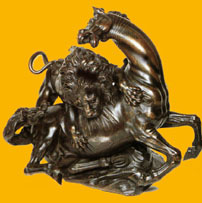
By Susini
Bronzes of the 16th and 17th centuries represent a fascinating theme for collectors who however must work hard to become connoisseurs in order to detect fine pieces and make good business at the same time.
These bronzes are among the most beautiful objects of art to be found on the market but, strangely enough, they don't always reach big prices at auction.
The rediscovery, of antique statues in several archeological sites in Italy at the end of the 14th century resulted in a majorbreak between sculptors who were attached to the traditional religious art and those who came to prefer mythological themes in copying these antique statues. Nevertheless, the latter brought about a revolution which started in Florence in 1336 when Andrea Pisano created the monumental door of the town Baptistery with the help of a bronze founder named Rossi from Perugia. In 1403, Lorenzo Ghiberti, in conceiving the "Heaven's doors" on the same spot launched at the same time an irreversible trend which went on to provoke deep changes in the art of sculpture.
In effect, for the first time since the fall of the Roman Empire, there were artists who turned their attention to creating equestrian and nude statues and it was from Florence and Padua that the new bronze techniques were developed before reaching the rest of Italy and neighbouring countries such as Germany, the southern part of the Netherlands and France.
Sculptors of the 15th century and of the beginning of the 16th century, drew largely their inspiration from many works created during Greek and Roman times, many centuries ago.
They soon went beyond the stage of copying to give a personal and talented touch to their works and some of them produced masterpieces which became rapidly in demand among European Courts.
A GOLDEN ERA WHICH LASTED
TWO CENTURIES
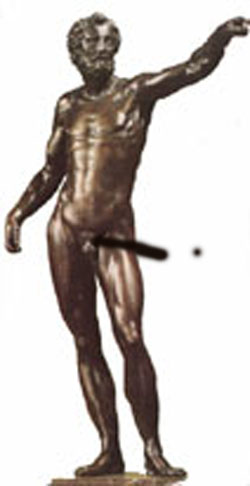
By Andrea Sansovino
The craze for bronze statues and statuettes lasted over more than two centuries until Rococo and the use of gold ornaments during the 18th century became a dominant feature that made obsolete most creations of the preceding periods. The Florentine and Antwerp cabinets of the 17th century, table clocks made between 1550 and 1720, massive pieces of furniture and those exquisite bronzes that decorated hundreds of then incomfortable castles and mansions became outdated and disappeared under layers of dust in many attics.
The 18th century was all devoted to showiness in styles and to space. Furniture were given round shapes, armchairs received soft cushions and sculptors preferred marble instead of bronze to create human-size statues to ornate monumental mansion halls or parks. Anf if bronze founders were still active that was mainly to produce andirons or clock cases as well as chimney, door and furniture ornaments.
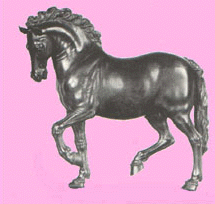 Many bronze artists merely became craftsmen while a majority of sculptors limited themselves to produce statues in marble or terracotta. Many bronze artists merely became craftsmen while a majority of sculptors limited themselves to produce statues in marble or terracotta.
By 1750 only a few art lovers knew about the great sculptors of the 15th century such as Donatello, Bartolomeo Bellano, Michelozzo, Andrea del Verrocchio, Piero Jacopo Bonacolzi called Antico, Antonio Pollaiuolo, Adriano Fiorentino, Andrea Sansovino, Severano da Ravenna or 16th century artists like Tullio and Antonio Lombardo, Alessandro Leopardi, Vittore Camelio, Jacopo Tatti called Sansovino, Michelangelo, Agostino Zoppo, Francesco da Sangallo, Baccio Bandinelli, Pietro da Barga, Benvenutto Cellini, Giovanni Rustici, Niccolo Tribolo, Tiziano Minio, Francesco da Santa Agata, Desiderio da Firenze, Riccio, Pierino da Vinci, Vincenzo de Rossi, Danese Cattaneo, Bartolomeo Ammanati, Vincenzo Danti, Giambologna, Leone Leoni, Hubert Gerhard, Angelus de Rubeis, Girolamo Campagna, Giulio del Moro, Gregor van der Schardt, Barthélémy Prieur, Tiziano Aspetti or Adriaen de Vries and not to forget some 17th century masters such as Antonio and Gianfranco Susini, Pietro and Ferdinand Tacca, Niccolo Roccatagliata, Pietro Francavilla, Hans Krumper, Pierre Puget and still many others.
The Industrial revolution of the 19th century however drove certain people to show some interest in Middle-Age and Renaissance works, notably around 1830 with the restoration of Roman and Gothivalrous novels, particularly by Walter Scott.

By Tiziano Aspetti
The new industrial magnates of the time started to collect these small statues and statuettes which had remained forgotten for so long until museums were created and art historians came on to embark on determining the authorship of many of these bronzes. During the second half of the 19th century and until the 1960's, the hunt for 16th and 17th century bronzes amplified thanks to the passion shown by collectors such as the Rotheschilds, the Jacquemart-André couple, David Weill, Seligmann, Hirsch, Adda, Broglio, Frey, David Daniels, Strauss, Thomas Flannery, Blumka or Pope-Hennessy among others.
Only a century ago, Italy was above all seeking to develop its economy rather than to preserve its artistic treasures. Following the social turmoils which affected the Peninsula between 1880 and 1914, many landowners were forced to sell their estates and many important art works Any rich European could come to Italy, visit historical sites and buy art treasures at ridiculous prices from local antique dealers. Today, any sum spent in 1880 on a superb Renaissance painting would just be enough to acquire an average 17th century picture from a small dealer.
However, 100 years ago, the art market was nothing but a kind of private club for wealthy people who found going on a spending spree in certain countries as much amusing as hunting in Africa or India. In one way or another they brought trophies back home and it was not before the end of the first World War that the market started to open itself to other categories of collectors. However, it was only after 1970 that it became a real economical entity at international level.
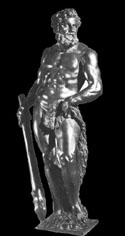
By Segala |
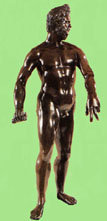
By Giambologna |
Today, the market is still building up but as for 16th and 17th century bronzes, offers have dwindled since most masterpieces are now in the collections of museums, institutions or some magnates. All the more,most newcomers to the art market have been attracted by modern and contemporary art pieces which are more in accordance with today's tastes.
By leaving the 1987-1990 speculation period out of consideration, one should note that among some 200 bronze statuettes offered for sale at auction throughout the world annually, there are still some remarkable Renaissance pieces which should reach better prices than those that have been recorded since the second half of 1995. These bronzes are enough beautiful and rare to attract new collectors, especially those who claim to be real art lovers. But their mesmerizing power seems to have little effect since collectors need to cultivate their knowledge to enhance their chances of finding genuine pieces as it is known that experts sometimes deliver wrong judgements. In addition, some remarkable forgeries were produced during the 19th century while other fakes have been appearing on the market during the past 15 years. The small number of collectors, the need to spend years learning about the subject, the increasing number of fakes in auction sales, have somewhat been contributing to provoke a slump in prices during the past two years.
All these factors have left their marks in recent big sales as many statuettes with estimates ranging from 100,000 to one million dollars have remained unsold. As a result, and contradictory to their historical importance and their rarity, many fine sculptures are now relatively cheap on the market and this is really hard to understand because beauty and scarcity usually mean big prices. Not long ago, a Giambologna work could fetch 250,000 dollars and more while a group representing the rape of the Sabines went beyond 4 million dollars and a small horse by Adriaen de Vries topped the 1,7 million dollar mark in two separate Paris sales. Heighdays are behind us. Nevertheless, this situation seems profitable to collectors who can buy masterpieces at low prices.
Good for them ! Adrian Darmon
|
|
|
|